NCERT Solutions Class 10 Maths
Chapter – 6 (Triangles)
The NCERT Solutions in English Language for Class 10 Mathematics Chapter – 6 Triangles Exercise 6.2 has been provided here to help the students in solving the questions from this exercise.
Chapter : 6 Triangles
- NCERT Class 10 Maths Solution Ex – 6.1
- NCERT Class 10 Maths Solution Ex – 6.3
- NCERT Class 10 Maths Solution Ex – 6.4
- NCERT Class 10 Maths Solution Ex – 6.5
- NCERT Class 10 Maths Solution Ex – 6.6
Exercise – 6.2
1. In figure. (i) and (ii), DE || BC. Find EC in (i) and AD in (ii).
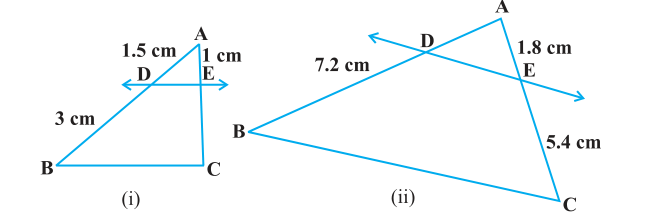
Solution –
(i) Given, in △ ABC, DE || BC
∴ [Using Basic proportionality theorem]
⇒
⇒ EC = 3/1.5
⇒ EC = 2 cm
Hence, EC = 2 cm.
(ii) Given, in △ ABC, DE || BC
∴ [Using Basic proportionality theorem]
⇒
⇒ AD = 1.8 × 7.2/5.4
⇒ AD = 2.4
Hence, AD = 2.4 cm.
2. E and F are points on the sides PQ and PR, respectively of a ΔPQR. For each of the following cases, state whether EF || QR.
(i) PE = 3.9 cm, EQ = 3 cm, PF = 3.6 cm and FR = 2.4 cm
(ii) PE = 4 cm, QE = 4.5 cm, PF = 8 cm and RF = 9 cm
(iii) PQ = 1.28 cm, PR = 2.56 cm, PE = 0.18 cm and PF = 0.63 cm
Solution – Given, in ΔPQR, E and F are two points on side PQ and PR, respectively. See the figure below;
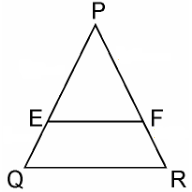
(i) Given, PE = 3.9 cm, EQ = 3 cm, PF = 3.6 cm and FR = 2,4 cm
Therefore, by using Basic proportionality theorem, we get,
= 1.3
And
= 1.5
So, we get, PE/EQ ≠ PF/FR
Hence, EF is not parallel to QR.
(ii) Given, PE = 4 cm, QE = 4.5 cm, PF = 8cm and RF = 9cm
Therefore, by using Basic proportionality theorem, we get,
=
And,
So, we get here,
Hence, EF is parallel to QR.
(iii) Given, PQ = 1.28 cm, PR = 2.56 cm, PE = 0.18 cm and PF = 0.36 cm
EQ = PQ – PE = 1.28 – 0.18 = 1.10 cm
And,
FR = PR – PF = 2.56 – 0.36 = 2.20 cm
So,
=
——————— (i)
And,
—————– (ii)
So, we get here,
Hence, EF is parallel to QR.
3. In the figure, if LM || CB and LN || CD, prove that AM/AB = AN/AD
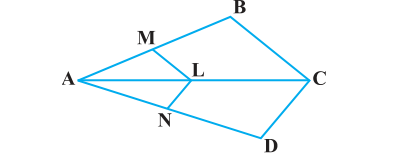
Solution –
In the given figure, LM || CB
By using basic proportionality theorem, we get,
AM/MB = AL/LC ——————— (i)
Similarly, LN || CD
∴ AN/AD = AL/LC ——————— (ii)
From (i) and (ii), we get
AM/MB = AN/AD
Hence, proved.
4. In the figure, DE||AC and DF||AE. Prove that BF/FE = BE/EC
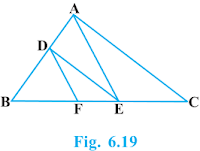
Solution –
In ΔABC, DE || AC (Given)
∴ BD/DA = BE/EC —————– (i) [By using Basic Proportionality Theorem]
In ΔABC, DF || AE (Given)
∴ BD/DA = BF/FE —————– (ii) [By using Basic Proportionality Theorem]
From equation (i) and (ii), we get
BE/EC = BF/FE
Hence, proved.
5. In the figure, DE||OQ and DF||OR, show that EF||QR.
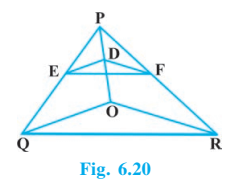
Solution –
In ΔPQO, DE || OQ (Given)
∴ PD/DO = PE/EQ —————– (i) [By using Basic Proportionality Theorem]
In ΔPQO, DE || OQ (Given)
∴ PD/DO = PF/FR —————– (ii) [By using Basic Proportionality Theorem]
From equation (i) and (ii), we get
PE/EQ = PF/FR
In ΔPQR, EF || QR. [By converse of Basic Proportionality Theorem]
6. In the figure, A, B and C are points on OP, OQ and OR respectively such that AB || PQ and AC || PR. Show that BC || QR.
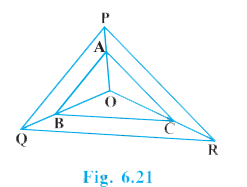
Solution –
In ΔOPQ, AB || PQ (Given)
∴ OA/AP = OB/BQ —————– (i) [By using Basic Proportionality Theorem]
In ΔOPR, AC || PR (Given)
∴ OA/AP = OC/CR —————– (ii) [By using Basic Proportionality Theorem]
OB/BQ = OC/CR
7. Using Basic proportionality theorem, prove that a line drawn through the mid-points of one side of a triangle parallel to another side bisects the third side. (Recall that you have proved it in Class IX).
Solution –
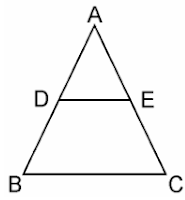
Given : ΔABC in which D is the mid point of AB such that AD=DB.
A line parallel to BC intersects AC at E as shown in above figure such that DE || BC.
To Prove : E is the mid point of AC.
Proof : D is the mid-point of AB.
∴ AD = DB
⇒ AD/BD = 1 —————– (i)
In ΔABC, DE || BC,
Therefore, AD/DB = AE/EC [By using Basic Proportionality Theorem]
⇒ 1 = AE/EC [From equation (i)]
∴ AE = EC
Hence, E is the mid point of AC.
8. Using Converse of basic proportionality theorem, prove that the line joining the mid-points of any two sides of a triangle is parallel to the third side. (Recall that you have done it in Class IX).
Solution –

Given : ΔABC in which D and E are the mid points of AB and AC respectively such that AD=BD and AE=EC.
To Prove : DE || BC
Proof : D is the mid point of AB (Given)
∴ AD = DB
⇒ AD/BD = 1 —————– (i)
Also, E is the mid-point of AC (Given)
∴ AE = EC
⇒ AE/EC = 1 [From equation (i)] —————– (ii)
From equation (i) and (ii), we get
AD/BD = AE/EC
Hence, DE || BC [By converse of Basic Proportionality Theorem]
9. ABCD is a trapezium in which AB || DC and its diagonals intersect each other at the point O. Show that AO/BO = CO/DO.
Solution –
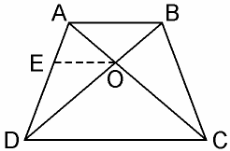
Given : ABCD is a trapezium in which AB || DC in which diagonals AC and BD intersect each other at O.
To Prove : AO/BO = CO/DO
Construction : Through O, draw EO || DC || AB
Proof : In ΔADC, we have
OE || DC (By Construction)
∴ AE/ED = AO/CO —————– (i) [By using Basic Proportionality Theorem]
In ΔABD, we have
OE || AB (By Construction)
∴ DE/EA = DO/BO —————– (ii) [By using Basic Proportionality Theorem]
From equation (i) and (ii), we get
AO/CO = BO/DO
⇒ AO/BO = CO/DO
Hence, proved.
10. The diagonals of a quadrilateral ABCD intersect each other at the point O such that AO/BO = CO/DO. Show that ABCD is a trapezium.
Solution –
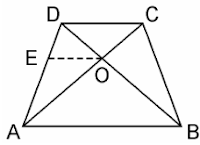
Given : Quadrilateral ABCD in which diagonals AC and BD intersects each other at O such that AO/BO = CO/DO.
To Prove : ABCD is a trapezium
Construction : Through O, draw line EO, where EO || AB, which meets AD at E.
Proof : In ΔDAB, we have
EO || AB
∴ DE/EA = DO/OB —————– (i) [By using Basic Proportionality Theorem]
Also, AO/BO = CO/DO (Given)
⇒ AO/CO = BO/DO
⇒ CO/AO = BO/DO
⇒ DO/OB = CO/AO —————– (ii)
From equation (i) and (ii), we get
DE/EA = CO/AO
Therefore, By using converse of Basic Proportionality Theorem, EO || DC also EO || AB
⇒ AB || DC.
Hence, quadrilateral ABCD is a trapezium with AB || CD.

Leave a Reply